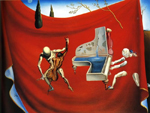
"Everything that Rises Must Converge"
"There was in him an evil urge to break her spirit" (489).
Flannery O'Connor's "Everything that Rises Must Converge" (1965)
Points
for Reflection
Flannery O'Connor's "Everything that Rises Must Converge" (1965), 485-500
- Julian feels himself "sacrificed" to the "pleasure" of his mother (486). Is this an accurate assessment of his situation?
- at what points does O'Connor allow her reader to side with Julian against his mother?
- is the paragraph at the top of page 492 that begins, The further irony . . ." an example of free indirect discourse?
- following his decision to "openly [declare] war on" his mother (492), what aggressive actions does Julian take?
- does the story provide, implicitly, a rationale for why Julian "had never been successful at making any Negro friends" (494)?
- why might O'Connor have placed on the large black woman's head a hat which is the mirror image of his mother's hat (495, 485)?
- what is the lesson Julian fears his mother will not have learned upon recognizing that she's wearing the same hat as a black woman (496)? Is he correct in his assumption that hse has learedn nothing? Is it possible for the reader to know, or does Julian's perspective color our own too much?
- does Julian's mother racism impact her treatment of the little black boy, or does her racism remain quiescent during this particular interaction?
- the following passage captured whose point of view, that of Julian, or that of the narrator? "[H]er eyes, sky-blue, were as innocent and untouched by experience as they must have been when she was ten" (485). Does Julian allow the idea of her innocence to lesson his judgment of her failings (496 mid)?
- why does Julian keep thinking about the threadbare mansion lost to him and his family line (488 mid, 494 top, 499 bot)? What does it represent to him?
- consider the short story's title. Does it operate on multiple levels? Is it an accurate way of summing up both the truth Julian holds high prior to the story's end, and a new truth he's confronted with by the conclusion?
- at how many different points does O'Connor foreshadow the tale's surprising conclusion?
- O'Connor believes that her stories contain the promise of redemption. Do you find evidence of this in the present story?

Music, the Red Orchestra, The Seven Arts (1957)
oil on canvas
Salvador Dalí
Dr. Paul Marchbanks
pmarchba@calpoly.edu
![]()
